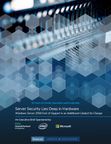- Community Home
- >
- Servers and Operating Systems
- >
- Servers & Systems: The Right Compute
- >
- The IT security challenges small businesses face a...
Categories
Company
Local Language
Forums
Discussions
Forums
- Data Protection and Retention
- Entry Storage Systems
- Legacy
- Midrange and Enterprise Storage
- Storage Networking
- HPE Nimble Storage
Discussions
Forums
Discussions
Discussions
Discussions
Forums
Discussions
Discussion Boards
Discussion Boards
Discussion Boards
Discussion Boards
- BladeSystem Infrastructure and Application Solutions
- Appliance Servers
- Alpha Servers
- BackOffice Products
- Internet Products
- HPE 9000 and HPE e3000 Servers
- Networking
- Netservers
- Secure OS Software for Linux
- Server Management (Insight Manager 7)
- Windows Server 2003
- Operating System - Tru64 Unix
- ProLiant Deployment and Provisioning
- Linux-Based Community / Regional
- Microsoft System Center Integration
Discussion Boards
Discussion Boards
Discussion Boards
Discussion Boards
Discussion Boards
Discussion Boards
Discussion Boards
Discussion Boards
Discussion Boards
Discussion Boards
Discussion Boards
Discussion Boards
Discussion Boards
Discussion Boards
Discussion Boards
Discussion Boards
Discussion Boards
Discussion Boards
Discussion Boards
Discussion Boards
Community
Resources
Forums
Blogs
- Subscribe to RSS Feed
- Mark as New
- Mark as Read
- Bookmark
- Receive email notifications
- Printer Friendly Page
- Report Inappropriate Content
The IT security challenges small businesses face and how to address them
IT security must be part of every small business technology plan. Discover security challenges unique to small businesses and learn how to create a multilayered security strategy.
Because small businesses face unique challenges that make them more susceptible to hacks, attacks, and breaches, IT security and 
Common challenges to small business IT security
Many small businesses share similar IT and cybersecurity challenges. Here are some of the main reasons small businesses are more susceptible to security threats:
- Security budget shortfall—The root of most SMB security issues is a lack of money. TechRepublic reports that nearly thirty percent of SMBs spend under $1,000 per year on IT security. Yet, per com, the average cost of a data breach for an SMB is $149,000. Few small businesses could afford such a sum. In comparison, investing in security is a smarter and less costly choice.
- No dedicated security staff—Related to being short on funds, small businesses don't always have dedicated security professionals on staff. 52 percent of SMBs don't have committed IT security personnel, according to TechRepublic,. This often means that security duties are, at best, shared by multiple people or, at worst, ignored. A piecemeal approach to security often leaves vulnerabilities undetected.
- Little to no employee training—To hackers, employees are the weakest links in a company and the easiest to exploit. Especially in a small business that lacks an IT team, staff might not know how to recognize a phishing or social engineering attack. They might not understand the importance of protecting their devices. Compounding matters, hackers have become far more sophisticated in their attacks. With their operations now resembling organized crime syndicates, even trained employees sometimes find it hard to identify a hacking attempt.
The importance of multilayered security for small businesses
Businesses of all sizes need to set up multilayered protections that keep authorized staff in and unauthorized people out. No single solution will work for every business, but successful plans follow a common path.
A good strategy for multilayered security is to start from the outside, or edge, of your network and work in. Safeguarding the edge of your network includes protecting your internet gateway and local area connections through routers, setting up network permissions, and setting up safe listed and excluded listed sites. These lists prevent visits to unauthorized websites.
The next layer to tackle is endpoint security. Installing antivirus, malware, and anti-spyware programs on company devices protects both company users and assets. Bolstering endpoint security can also involve setting password standards and teaching employees how to identify common attacks, such as phishing and ransomware.
Finally, protect your hardware and software by keeping on top of installations of the latest patches and updates. Hackers keep track of security vulnerabilities for easy inroads into a company. Applying the most current patches is a reliable way to prevent attacks.
You can also use the cybersecurity framework from the National Institute of Standards and Technology (NIST) to guide your security approach:
- Identify—Discover your vulnerabilities.
- Protect—Implement basic security measures to fix those vulnerabilities.
- Detect—Add monitoring and detection capabilities so you can spot a breach as it's attempted or soon after it occurs.
- Respond—Act on a predetermined plan to stop an attempted or successful breach.
- Recover—Have a plan in place to restore function after a breach, recover any lost data, and learn from the incident to prevent a similar event from happening again.
Ways to keep your business secure
Once you have a multilayered security strategy in place, it's time to consider specific solutions. When evaluating your options, don't forget to account for the security of your server hardware. Having servers that are secure by design will make the rest of your security efforts much easier.
HPE server products, for example, come with built-in security solutions and features. HPE ProLiant Gen10 Servers have been named the most secure industry-standard servers. And HPE's cybersecurity solutions, including the exclusive Silicon Root of Ttrust and the Aruba Policy Enforcement Firewall, were recently recognized by the Cyber Catalyst program for their ability to reduce risk.
HPE also helps small businesses enhance their security posture; representatives from HPE Pointnext can perform risk assessments and help your business recover after a breach occurs.
Finally, HPE protects its supply chain, a vulnerability often overlooked by other companies. HPE secures each product at every step of its journey: from the factory floor all the way to the end user. To do this, HPE uses safeguards that include holographic labels, intrusion detection devices, and more.
Knowing your business's vulnerabilities, creating a multilayered plan, and relying on secure products and services are all vital steps to safeguarding IT security for your small business. Watch this video to learn more about how your small business can create its own multilayered security plan.
Featured articles
- An innovation war: Cybersecurity vs. cybercrime
- Want to know the future of technology? Sign up for weekly insights and resources
Learn more about HPE Small Business Solutions.

Or are you ready to purchase? Visit the HPE Store.

Server Experts
Hewlett Packard Enterprise
twitter.com/HPE_SMB
linkedin.com/showcase/hpe-servers-and-systems/
hpe.com/servers
- Back to Blog
- Newer Article
- Older Article
- PerryS on: Explore key updates and enhancements for HPE OneVi...
- Dale Brown on: Going beyond large language models with smart appl...
- alimohammadi on: How to choose the right HPE ProLiant Gen11 AMD ser...
- ComputeExperts on: Did you know that liquid cooling is currently avai...
- Jams_C_Servers on: If you’re not using Compute Ops Management yet, yo...
- AmitSharmaAPJ on: HPE servers and AMD EPYC™ 9004X CPUs accelerate te...
- AmandaC1 on: HPE Superdome Flex family earns highest availabili...
- ComputeExperts on: New release: What you need to know about HPE OneVi...
- JimLoi on: 5 things to consider before moving mission-critica...
- Jim Loiacono on: Confused with RISE with SAP S/4HANA options? Let m...
-
COMPOSABLE
77 -
CORE AND EDGE COMPUTE
146 -
CORE COMPUTE
158 -
HPC & SUPERCOMPUTING
138 -
Mission Critical
88 -
SMB
169
